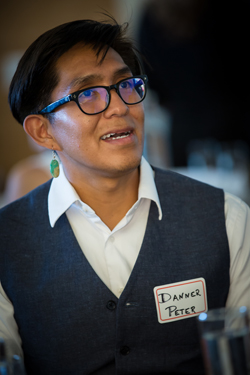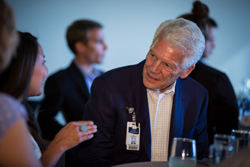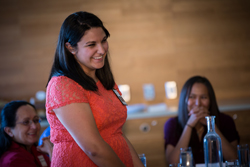With displays of traditional Native American dress and artifacts as reminders of their proud heritage, a group of bright, young students radiated optimism and excitement at the welcome dinner for the Native American Research Internship (NARI), held at the Natural History Museum of Utah. This year, the program is hosting students from 12 tribal nations, 12 states, and 18 universities. While many are newcomers, some have decided to return for their second and even third summers.
NARI offers an opportunity for native students to encourage and explore interests in medicine and biomedical research, two fields in which Native Americans are the most underrepresented minority group. The highly competitive program offers students 10 weeks of hands-on research experience with top scientists and physicians as their mentors.
"NARI is becoming the national program for science in the Native American community," said Carrie Byington, M.D., co-director of the Center for Clinical and Translational Science, which supports the program. At the welcome dinner she explained that she has faith not just in NARI, but also in the students themselves. "You are amongst the best and brightest students in the country," she told them.

Among them is Danner Peter, a Navajo who is returning to the program for a third summer to continue research in HIV/AIDS prevention. He just finished his Masters in Public Health at the University of Hawaii and is considering either medical school or a Ph.D. "Trying to find support systems is hard because of the lack of resources for native students," he said, but NARI has helped nurture his interests.
Jenna Murray, of the Eastern Shoshone Tribe in Wyoming, also spoke to the challenges she has faced while pursuing the sciences, especially as a Native American woman.
"We're traditionally underrepresented in medicine and education in general," she said, "but programs like this are why numbers are growing."
It is due to this lack of representation, in fact, that Murray was inspired to become a doctor. When she lived on the reservation in Fort Washakie and visited the Indian Health Service (IHS), the lack of native doctors and a stark cultural boundary were apparent. "In order to fully understand the patients when working somewhere like IHS, it does help to be native—you're able to connect on that level," she said. Murray, who will be a senior at Colorado College next year, will be continuing her clinical research in chronic kidney disease this summer.
A resounding benefit of the program, both Murray and Peter said, is the network that it creates for the interns. Not only does it provide an opportunity to build a professional network among the interns' scientific mentors, but the relationships among the interns themselves become equally as invaluable.

"I consider a lot of the NARI interns my close friends," said Steven Just, NARI's coordinator and a former intern. He referred not only to the friendships but also to the "peer mentorship" he gained from the program.
Run by the University of Utah Health Sciences, NARI began in 2010 after a discussion between Edward Clark, M.D., now the chair of pediatrics, and renowned Navajo health advocate Beverly Pigman, whom Clark described as an "incredibly dedicated and fierce guardian of Navajo culture and tradition." Pigman insisted that the University of Utah needed to build a program that could provide Native American students with opportunities that had been difficult to find. Clark recalls that the program started on a shoestring budget. It has been growing ever since.
Today, the much-lauded program is backed by three NIH-funded grants, and so far has had 60 graduates. 16 of those participants are still working on their undergraduate degrees while the other 44 have graduated from university. Impressively, half of the university graduates are now pursuing medical and graduate studies.

The interns are not the only beneficiaries of the program, said Byington. She stressed the mutual impact the program brings to fellow students and mentors—not just in offering an extra mind and set of hands but also in introducing a rich diversity that can provide a special kind of education.
"When we work with NARI students we learn so much about native beliefs, culture, strengths, and opportunities," Byington told the interns. "Share your wisdom with us."
-written by Shelley Miller